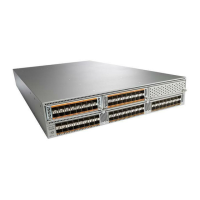f) Copy the kickstart and system images to the switch bootflash using a transfer protocol. You can use ftp, tftp, scp,
or sftp.
Step 2
Install the new images.
Example:
switch# install all kickstart bootflash:n5000-uk9-kickstart.4.0.1a.N1.0.62.bin system
bootflash:n5000-uk9.4.0.1a.N1.0.62.bin
switch# install all kickstart bootflash:n5500-uk9-kickstart.4.0.1a.N1.0.62.bin system
bootflash:n5500-uk9.4.0.1a.N1.0.62.bin
The install all command performs the following actions:
•
Performs compatibility checks (equivalent to the show incompatibility command) for the images that you have
specified. If there are compatibility issues, an error message is displayed and the installation does not proceed.
•
Displays the compatibility check results and displays whether the installation is disruptive.
•
Provides a prompt to allow you to continue or abort the installation.
A disruptive installation causes traffic disruption while the switch reboots.Note
•
Updates the boot variables to reference the specified images and saves the configuration to the startup configuration
file.
Step 3
After the switch completes the installation, log in and verify that the switch is running the required software version.
Example:
switch# show version
Initial Configuration
Configuration Prerequisites
The following procedure is a review of the tasks you should have completed during hardware installation.
These tasks must be completed before you can configure the switch.
SUMMARY STEPS
1.
Verify the following physical connections for the new Cisco Nexus device:
2.
Verify that the default console port parameters are identical to those of the computer terminal (or terminal
server) attached to the switch console port:
DETAILED STEPS
Step 1
Verify the following physical connections for the new Cisco Nexus device:
Cisco Nexus 5500 Series NX-OS Fundamentals Configuration Guide, Release 7.x
20 OL-30890-01
Using the Cisco NX-OS Setup Utility
Initial Configuration

